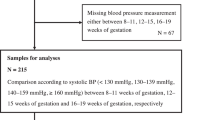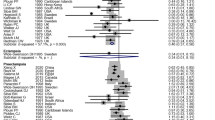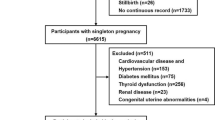Abstract
Increasing evidence indicates that hypertension in pregnancy is an under-recognized risk factor for cardiovascular disease (CVD). Compared with women who have had normotensive pregnancies, those who are hypertensive during pregnancy are at greater risk of cardiovascular and cerebrovascular events and have a less favorable overall risk profile for CVD years after the affected pregnancies. One factor that might underlie this relationship is that hypertensive disorders of pregnancy (pre-eclampsia, in particular) and CVD share several common risk factors (e.g. obesity, diabetes mellitus and renal disease). Alternatively, hypertension in pregnancy could induce long-term metabolic and vascular abnormalities that might increase the overall risk of CVD later in life. In both cases, evidence regarding risk-reduction interventions specific to women who have had hypertensive pregnancies is lacking. While awaiting results of large-scale studies, hypertensive disorders of pregnancy should be screened for during assessment of a woman's overall risk profile for CVD. Women at high risk must be monitored closely for conventional risk factors that are common to both CVD and hypertensive disorders of pregnancy and treated according to current evidence-based national guidelines.
Key Points
-
Compared with women who have a history of normotensive pregnancy, those who have a history of hypertensive disorders of pregnancy are at higher risk of cardiovascular and cerebrovascular events, and have a less favorable cardiovascular disease (CVD) risk profile, years after the affected pregnancy
-
Hypertensive disorders of pregnancy and CVD share several common risk factors; for example, obesity, diabetes and renal disease
-
Hypertension in pregnancy might modify the future risk of CVD by inducing long-term metabolic and vascular changes
-
Increasing evidence indicates that a history of hypertensive pregnancy is an under-recognized risk factor that could aid early identification of women who are at an increased risk of developing CVD
-
Women with a history of hypertensive pregnancy must be monitored closely for comorbidities and conventional risk factors for CVD and treated according to current evidence-based guidelines
This is a preview of subscription content, access via your institution
Access options
Subscribe to this journal
Receive 12 print issues and online access
$209.00 per year
only $17.42 per issue
Buy this article
- Purchase on Springer Link
- Instant access to full article PDF
Prices may be subject to local taxes which are calculated during checkout

Similar content being viewed by others
References
The Multiple Risk Factor Intervention Trial Research Group (1996) Mortality after 16 years for participants randomized to the multiple risk factor intervention trial. Circulation 94: 946–951
Centers for Disease Control (CDC) (1992) Trends in ischemic heart disease mortality—United States, 1980–1988. MMWR Morb Mortal Wkly Rep 41: 548–556
Mosca L et al. (1997) Cardiovascular disease in women: a statement for healthcare professionals from the American Heart Association. Circulation 96: 2468–2482
Mosca L et al. (2005) National study of physician awareness and adherence to cardiovascular disease prevention guidelines. Circulation 111: 499–510
Abuful A et al. (2005) Physicians' attitudes toward preventive therapy for coronary artery disease: is there a gender bias? Clin Cardiol 28: 389–393
Garovic VD et al. (2006) Hypertension in pregnancy is associated with microalbuminuria and cardiovascular events later in life [abstract]. J Am Soc Nephrol 17: 11A
McLaughlin MK and Roberts JM (1999) Cardiovascular adaptation to normal pregnancy: hemodynamic changes. In Chesley's Hypertensive Disorders in Pregnancy, 69–102 (Eds Lindheimer MD et al.) Stamford: Appleton & Lange
Martin U et al. (1999) Is normal pregnancy atherogenic? Clin Sci (Lond) 96: 421–425
Beral V (1985) Long term effects of childbearing on health. J Epidemiol Community Health 39: 343–346
Ness RB et al. (1994) Reproductive history and coronary heart disease risk in women. Epidemiol Rev 16: 298–314
Chesley SC et al. (1976) The remote prognosis of eclamptic women: sixth periodic report. Am J Obstet Gynecol 124: 446–459
[No authors listed] (2000) Report of the National High Blood Pressure Education Program Working Group on High Blood Pressure in Pregnancy [comment]. Am J Obstet Gynecol 183: S1–S22.
Chobanian AV et al. (2003) The seventh report of the Joint National Committee on Prevention, Detection, Evaluation, and Treatment of High Blood Pressure: the JNC 7 report. JAMA 289: 2560–2572
Sibai BM et al. (1983) Pregnancy outcome in 211 patients with mild chronic hypertension. Obstet Gynecol 61: 571–576
Herrick WW and Tillman AJB (1936) The mild toxemias of pregnancy: their relation to cardiovascular and renal disease. Am J Obstet Gynecol 31: 832–844
Adams EM and MacGillivray I (1961) Long-term effect of pre-eclampsia on blood-pressure. Lancet 2: 1373–1375
Singh MM et al. (1974) A study of the long-term effects of pre-eclampsia on blood pressure and renal function. J Obstet Gynaecol British Commonwealth 81: 903–906
Barker DJ (1995) Fetal origins of coronary heart disease. BMJ 311: 171–174
Davey Smith G et al. (1997) Birth weight of offspring and mortality in the Renfrew and Paisley study: prospective observational study. BMJ 315: 1189–1193
Smith GD et al. (2000) Relation between infants' birth weight and mothers' mortality: prospective observational study. BMJ 320: 839–840
Chesley LC (2000) Recognition of the long-term sequelae of eclampsia. Am J Obstet Gynecol 182: 249–250
Lindeberg S et al. (1988) A prospective controlled five-year follow-up study of primiparas with gestational hypertension. Acta Obstet Gynecol Scand 67: 605–609
Kotchen JM et al. (1982) Blood pressure of young mothers and their children after hypertension in adolescent pregnancy: six- to nine-year follow-up. Am J Epidemiol 115: 861–867
Selvaggi L et al. (1988) Long term follow-up of women with hypertension in pregnancy. Int J Gynaecol Obstet 27: 45–49
Carleton H et al. (1988) Remote prognosis of preeclampsia in women 25 years old and younger. Am J Obstet Gynecol 159: 156–160
Sibai BM et al. (1986) Severe preeclampsia-eclampsia in young primigravid women: subsequent pregnancy outcome and remote prognosis. Am J Obstet Gynecol 155: 1011–1016
Wikström A-K et al. (2005 The risk of maternal ischaemic heart disease after gestational hypertensive disease. BJOG 112: 1486–1491
Croft P and Hannaford PC (1989) Risk factors for acute myocardial infarction in women: evidence from the Royal College of General Practitioners' oral contraception study. BMJ 298: 165–168
Jonsdottir LS et al. (1995) Death rates from ischemic heart disease in women with a history of hypertension in pregnancy. Acta Obstet Gynecol Scand 74: 772–776
Irgens HU et al. (2001) Long term mortality of mothers and fathers after pre-eclampsia: population based cohort study. BMJ 323: 1213–1217
Arnadottir GA et al. (2005) Cardiovascular death in women who had hypertension in pregnancy: a case-control study. BJOG 112: 286–292
Lowe DT (2000) Nitric oxide dysfunction in the pathophysiology of preeclampsia. Nitric Oxide 4: 441–458
Islami D et al. (2001) Is cellular fibronectin a biological marker for pre-eclampsia? Eur J Obstet Gynecol Reproduct Biol 97: 40–45
Friedman SA et al. (1995) Biochemical corroboration of endothelial involvement in severe preeclampsia. Am J Obstet Gynecol 172: 202–203
Halim A et al. (1996) Plasma P selectin (GMP-140) and glycocalicin are elevated in preeclampsia and eclampsia: their significances. Am J Obstet Gynecol 174: 272–277
Krauss T et al. (1997) Circulating endothelial cell adhesion molecules as diagnostic markers for the early identification of pregnant women at risk for development of preeclampsia. Am J Obstet Gynecol 177: 443–449
Greer IA et al. (1994) Increased concentrations of cytokines interleukin-6 and interleukin-1 receptor antagonist in plasma of women with preeclampsia: a mechanism for endothelial dysfunction? Obstet Gynecol 84: 937–940
Vince GS et al. (1995) Interleukin-6, tumour necrosis factor and soluble tumour necrosis factor receptors in women with pre-eclampsia. British J Obstet Gynaecol 102: 20–25
Maynard SE et al. (2003) Excess placental soluble fms-like tyrosine kinase 1 (sFlt1) may contribute to endothelial dysfunction, hypertension, and proteinuria in preeclampsia. J Clin Invest 111: 649–658
Sibai BM et al. (1995) Risk factors for preeclampsia in healthy nulliparous women: a prospective multicenter study. The National Institute of Child Health and Human Development Network of Maternal-Fetal Medicine Units. Am J Obstet Gynecol 172: 642–648
Kaaja R (1998) Insulin resistance syndrome in preeclampsia. Semin Reprod Endocrinol 16: 41–46
Sibai BM et al. (1997) Risk factors associated with preeclampsia in healthy nulliparous women. The Calcium for Preeclampsia Prevention (CPEP) Study Group. Am J Obstet Gynecol 177: 1003–1010
Dunne F et al. (2003) Pregnancy in women with type 2 diabetes: 12 years outcome data 1990–2002. Diabet Med 20: 734–738
Griffin BA (1999) Lipoprotein atherogenicity: an overview of current mechanisms. Proc Nutr Soc 58: 163–169
Hubel CA et al. (1998) Small low-density lipoproteins and vascular cell adhesion molecule-1 are increased in association with hyperlipidemia in preeclampsia. Metabolism 47: 1281–1288
Sattar N et al. (1997) Lipoprotein subfraction concentrations in preeclampsia: pathogenic parallels to atherosclerosis. Obstet Gynecol 89: 403–408
Gratacos E (2000) Lipid-mediated endothelial dysfunction: a common factor to preeclampsia and chronic vascular disease. Eur J Obstet, Gynecol Reproduct Biol 92: 63–66
Caro JF et al. (1996) Leptin: the tale of an obesity gene. Diabetes 45: 1455–1462
Wallace AM et al. (2001) Plasma leptin and the risk of cardiovascular disease in the West of Scotland Coronary Prevention Study (WOSCOPS). Circulation 104: 3052–3056
Davi G et al. (2002) Platelet activation in obese women: role of inflammation and oxidant stress. JAMA 288: 2008–2014
Teppa RJ et al. (2000) Free leptin is increased in normal pregnancy and further increased in preeclampsia. Metabolism 49: 1043–1048
Parthasarathy S and Santanam N (1994) Mechanisms of oxidation, antioxidants, and atherosclerosis. Curr Opin Lipidol 5: 371–375
Poranen AK et al. (1996) Lipid peroxidation and antioxidants in normal and pre-eclamptic pregnancies. Placenta 17: 401–405
Hubel CA et al. (1997) Increased ascorbate radical formation and ascorbate depletion in plasma from women with preeclampsia: implications for oxidative stress. Free Radic Biol Med 23: 597–609
Many A et al. (2000) Invasive cytotrophoblasts manifest evidence of oxidative stress in preeclampsia. Am J Pathol 156: 321–331
Chappell LC et al. (1999) Effect of antioxidants on the occurrence of pre-eclampsia in women at increased risk: a randomised trial. Lancet 354: 810–816
Poston L et al. (2006) Vitamin C and vitamin E in pregnant women at risk for pre-eclampsia (VIP trial): randomised placebo-controlled trial. Lancet 367: 1145–1154
Stampfer MJ et al. (1993) Vitamin E consumption and the risk of coronary disease in women. N Engl J Med 328: 1444–1449
Gale CR et al. (1995) Vitamin C and risk of death from stroke and coronary heart disease in cohort of elderly people. BMJ 310: 1563–1566
Ross R (1993) The pathogenesis of atherosclerosis: a perspective for the 1990s. Nature 362: 801–809
Thomson AJ et al. (1999) Leukocytes infiltrate the myometrium during human parturition: further evidence that labour is an inflammatory process. Hum Reprod 14: 229–236
Sacks GP et al. (1998) Normal pregnancy and preeclampsia both produce inflammatory changes in peripheral blood leukocytes akin to those of sepsis. Am J Obstet Gynecol 179: 80–86
Clark P et al. (1998) The neutrophil and preeclampsia. Semin Reprod Endocrinol 16: 57–64
Greer IA et al. (1991) Neutrophil activation is confined to the maternal circulation in pregnancy-induced hypertension. Obstet Gynecol 78: 28–32
Austgulen R et al. (1997) Increased maternal plasma levels of soluble adhesion molecules (ICAM-1, VCAM-1, E-selectin) in preeclampsia. Eur J Obstet Gynecol Reproduct Biol 71: 53–58
Freeman DJ et al. (2004) Short- and long-term changes in plasma inflammatory markers associated with preeclampsia. Hypertension 44: 708–714
Sattar N et al. (1997) Lipoprotein subfraction changes in normal pregnancy: threshold effect of plasma triglyceride on appearance of small, dense low density lipoprotein. J Clin Endocrinol Metabol 82: 2483–2491
Wolf M et al. (2001) Obesity and preeclampsia: the potential role of inflammation. Obstet Gynecol 98: 757–762
Ostlund E et al. (2001) Fibronectin is a marker for organ involvement and may reflect the severity of preeclampsia. Hypertens Pregnancy 20: 79–87
Powers RW et al. (2001) Homocysteine and cellular fibronectin are increased in preeclampsia, not transient hypertension of pregnancy. Hypertens Pregnancy 20: 69–77
Shaarawy M and Didy HE (1996) Thrombomodulin, plasminogen activator inhibitor type 1 (PAI-1) and fibronectin as biomarkers of endothelial damage in preeclampsia and eclampsia. Int J Gynaecol Obstet 55: 135–139
Paternoster D et al. (1994) Clotting inhibitors and fibronectin as potential markers in preeclampsia. Int J Gynaecol Obstet 47: 215–221
Kupferminc MJ (2003) Thrombophilia and pregnancy. Reproduct Biol Endocrinol 1: 111
Kupferminc MJ et al. (2000) Severe preeclampsia and high frequency of genetic thrombophilic mutations. Obstet Gynecol 96: 45–49
Mayer EL et al. (1996) Homocysteine and coronary atherosclerosis. J Am Coll Cardiol 27: 517–527
Potter van Loon BJ et al. (1993) The cardiovascular risk factor plasminogen activator inhibitor type 1 is related to insulin resistance. Metabolism 42: 945–949
Hubel CA et al. (2000) Dyslipoproteinaemia in postmenopausal women with a history of eclampsia. BJOG 107: 776–784
Laivuori H et al. (1996) Hyperinsulinemia 17 years after preeclamptic first pregnancy. J Clin Endocrinol Metabol 81: 2908–2911
Chambers JC et al. (2001) Association of maternal endothelial dysfunction with preeclampsia. JAMA 285: 1607–1612
Bar J et al. (1999) Microalbuminuria after pregnancy complicated by pre-eclampsia. Nephrol Dial Transplant 14: 1129–1132
Luft FC (2003) Pre-eclampsia and the maternal cardiovascular risk. Nephrol Dial Transplant 18: 860–861
Gant NF et al. (1973) A study of angiotensin II pressor response throughout primigravid pregnancy. J Clin Invest 52: 2682–2689
Wallukat G et al. (1999) Patients with preeclampsia develop agonistic autoantibodies against the angiotensin AT1 receptor. J Clin Invest 103: 945–952
Hubel CA et al. (2007) Agonistic angiotensin II type 1 receptor autoantibodies in postpartum women with a history of preeclampsia. Hypertension 49: 612–617
Brotman DJ et al. (2005) In search of fewer independent risk factors. Archiv Intern Med 165: 138–145
Fisher KA et al. (1981) Hypertension in pregnancy: clinical-pathological correlations and remote prognosis. Medicine 60: 267–276
Sattar N and Greer IA (2002) Pregnancy complications and maternal cardiovascular risk: opportunities for intervention and screening? BMJ 325: 157–160
Mosca L et al. (2007) Evidence-based guidelines for cardiovascular disease prevention in women: 2007 update. J Am Coll Cardiol 49: 1230–1250
Mann JI et al. (1976) Risk factors for myocardial infarction in young women. Br J Prev Soc Med 30: 94–100
[No authors listed] (1995) Venous thromboembolic disease and combined oral contraceptives: results of international multicentre case-control study. World Health Organization Collaborative Study of Cardiovascular Disease and Steroid Hormone Contraception. Lancet 346: 1575–1582
[No authors listed] (1996) Haemorrhagic stroke, overall stroke risk, and combined oral contraceptives: results of an international, multicentre, case-control study. WHO Collaborative Study of Cardiovascular Disease and Steroid Hormone Contraception. Lancet 348: 505–510
Brown DW et al. (2006) Preeclampsia and the risk of ischemic stroke among young women: results from the Stroke Prevention in Young Women Study. Stroke 37: 1055–1059
Hannaford P et al. (1997) Cardiovascular sequelae of toxaemia of pregnancy. Heart 77: 154–158
Smith GC et al. (2001) Pregnancy complications and maternal risk of ischaemic heart disease: a retrospective cohort study of 129,290 births. Lancet 357: 2002–2006
Kestenbaum B et al. (2003) Cardiovascular and thromboembolic events following hypertensive pregnancy. Am J Kidney Diseases 42: 982–989
Wilson BJ et al. (2003) Hypertensive diseases of pregnancy and risk of hypertension and stroke in later life: results from cohort study. BMJ 326: 845–849
Funai EF et al. (2005) Long-term mortality after preeclampsia. Epidemiology 16: 206–215
Ray JG et al. (2005) Cardiovascular health after maternal placental syndromes (CHAMPS): population-based retrospective cohort study. Lancet 366: 1797–1803
Acknowledgements
Désirée Lie, University of California, Irvine, CA, is the author of and is solely responsible for the content of the learning objectives, questions and answers of the Medscape-accredited continuing medical education activity associated with this article.
Author information
Authors and Affiliations
Corresponding author
Ethics declarations
Competing interests
The authors declare no competing financial interests.
Rights and permissions
About this article
Cite this article
Garovic, V., Hayman, S. Hypertension in pregnancy: an emerging risk factor for cardiovascular disease. Nat Rev Nephrol 3, 613–622 (2007). https://doi.org/10.1038/ncpneph0623
Received:
Accepted:
Issue Date:
DOI: https://doi.org/10.1038/ncpneph0623
This article is cited by
-
Dietary supplements and vascular function in hypertensive disorders of pregnancy
Pflügers Archiv - European Journal of Physiology (2023)
-
Altered cardiac and vascular stiffness in pregnancy after a hypertensive pregnancy
Journal of Human Hypertension (2022)
-
An observational claims data analysis on the risk of maternal chronic kidney disease after preterm delivery and preeclampsia
Scientific Reports (2021)
-
Targeting senescence improves angiogenic potential of adipose-derived mesenchymal stem cells in patients with preeclampsia
Biology of Sex Differences (2019)
-
Anti-angiogenesis and Preeclampsia in 2016
Current Hypertension Reports (2017)



